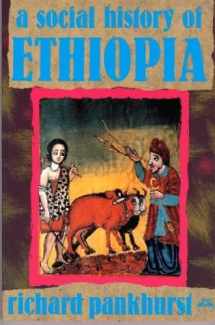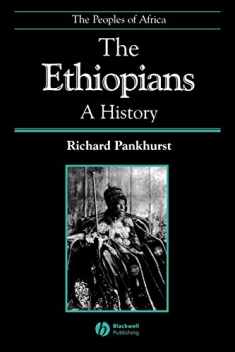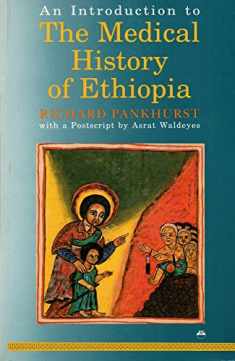
A Social History of Ethiopia: The Northern and Central Highlands from Early Medieval Times to the Rise of Emperor Tewodros II
Book details
Summary
Description
In introducing the present essay on the Social History of Ethiopia, it should be emphasised that the country, which today covers an area as large as France and Spain combined, has always been one of immense geographical and other contrasts. High mountains, which in the Samen range tower more than 4,600 metres above sea level, give way to flat lowlands which in the 'Afar depression sink below sea level. Temperature, which, geographically, is no less varied, ranges from the icy cold of the mountains, with frost, and in places even snow, through the temperate highlands - the site of most of the country's historic settlements - to the torrid lowlands, with the Red Sea and Gulf of Aden ports reckoned as among some of the hottest places in the world. Differences in rainfall have been no less dramatic, the torrential downpours of the highlands contrasting with minimal precipitation in the parches almost waterless lowlands. It follows that vegetation was equally varied, with tropical jungles, particularly in the west, deserts and semi-desert scrublands, mainly in the east and south, and fertile - but largely deforested - regions in many areas of medium elevation.
The population of the country, not surprisingly, came to terms with such greatly varying environments in different ways, with the result that the world's principal types of economic activity were all represented - with agriculturalists, many of them practicing plough agriculture, in the extensive highlands, pastoralists in the even more widespread lowlands, and hunters and gathers in the vicinity of the many rivers, lakes and forests. (This three-fold division is, however, far from rigid, for there was often much overlapping, particularly in the highlands where the supposed "agriculturalists" devoted much of their time to the upkeep of cattle which many farmers and peasants regarded as their principal source of wealth).
Ethiopia - like so many countries on the African continent - is in no less measure a land made up of varied ethic - and lingusitic - threads. It comprises members of no less than four broad language groups: Semitic, mainly in the north, but with pockets in the south (Gurage and Adare), Cushitic, mainly in the south, but with pockets in the north (Beja, Agaw, Saho, and 'Afar), Omotic (Wallamo, Kafa, Gemerra, etc.) in the south-west, and Nilo-Saharan in the far west, near the Sudan border. The situation was, however, historically far from static, for there were over the centuries major movements of population, notably in the ancient and medieval period when Tegres moved from north to south ; in the sixteenth, seventeenth and early eighteenth centuries when Oromos migrated from south to north; in the nineteenth century when there was once more a movement, mainly of Amharas, from north to south; as well as throughout the centuries to and from sundry national or provincial capitals. For this and other reasons bilingualism, and indeed multilingualism, may well have existed throughout this period.
The religious pattern - in which the world's three main monotheistic faiths are all represented - was no less varied. For centuries Christians of the Orthodox faith predominated in the all-important northern and central highlands, Muslims were no less dominant in most of the lowlands, particularly to the east, as well as at the great commercial centre of Harar, but were also of paramount importance as merchants throughout the region as a whole. Followers of traditional local faiths preponderated in the south-west (the source of much of the country's exports of gold, ivory, civet and slaves), but also, we may assume, exerted some cultural influence in the north where they accounted for no small proportion of the slave population which, we may surmise, was by no means instantly assimilated to the locally dominant faith or faiths. The Falasa, or Judaic Ethiopians, who constituted the smallest of the country's four religious groups, were located mainly in the north-west. Through their faith was in many ways distinct - both from other Ethiopians and from the Jews of other lands their social life had much in common with Ethiopian Orthodox Christians, with whom they shared the Ge'ez Old Testament, whose scribes often wrote out their sacred writings and whose Church schools they sometimes attended. They also had some cultural affinities with nearby Oemant who represented an intermediary faith between Judaism and an ancient Ethiopian religion often referred to as a form of Animism.
Such immense variations of physical and human geography coupled with those of language, culture and religion, inevitably resulted in the existence within the confines of the present-day Ethiopian region of many differing customs and ways of life. There ensured much cross-fertilisation of cultures and traditions, which still requires detailed study. Any comprehensive examination of so rich, and geographically varied, a history obviously requires many detailed monographs - for it would seem impossible, within the compass of one small volume such as this, to do justice to the rich variety of Ethiopia's historic social and cultural experience, either on a countrywide basis - or over the time span of more than a few centuries. Further factual studies, when completed, will doubtless lead to works of greater synthesis and interpretation.
The present volume, which is a planned as the first of a series dealing with various aspects of the country's varied social history, is devoted by and large to the northern and central highlands, and covers the period from early medieval times tot he region of Emperor Tewodros II which is considered a turning-point in the country's history - and serves at the same time as a point of departure for the dramatic changes that were to characterize the late nineteenth and twentieth centuries. The region under review was important in that it constituted the core of the traditional Ethiopian State, and was over the centuries to exercise no small influence on other parts of the country. The area was at the same time distinctive - and formed a cohesive entity - in that it had a unique highland, and predominantly Christian, culture. The region is moreover of special interest on account of its indigenous chronicles and hagiographies, and the many descriptions by foreign travelers, which made it, at least until the middle or second half of the nineteenth century, by far best documented part of Ethiopia. It is thus an area that can be studied over a considerable span of time.
Since the northern and central highlands in the period under review are so palpably better documented it would be impossible to devote anything like equal coverage to other parts of the country without adopting the arbitrary, and from the scholarly point of view surely misguided policy of suppressing available data on a region for which it is available, in the interests of geographical balance.
Even with the above strictly limited geographical confines generalisation is often hazardous. It has been possible within the time and space available to consider only some of the more important aspects from one district or village to another, for the communities under review were composed, it should not be forgotten, of individual men, women and children, who lived their varied lives as they could, or thought fit - in blissful ignorance of the foreign traveller's accounts, and other historical sources, upon which scholars base their accounts - and develop their interpretation - of traditional Ethiopian behaviour.
The present volume, conceived as a first installment towards a full Social History of Ethiopia, is primarily descriptive. it is intended to present a survey based on available sources, and thereby to lay a groundwork for other writers to develop more ambitious, comprehensive and interpretative, studies of old-time Ethiopian life. It is hoped at a later stage to publish companion volumes on the south of the country, as well as on the period from Tewodros to more recent times.
I should like to thank friends and colleagues who made this publication possible. I am grateful to Dr. Taddese Beyene, the devoted Director of the Institute of Ethiopian Studies, for his kind help and encouragement, as well as to Margaret Last for typing part of the first draft, to Amanda Woodlands for generously devoting her time to putting most of the text on computer, to my children Alula and Helen for initially helping me wrestle with that machine, to the computer wizard Bruno Neeser for producing IBM-compatible diskettes, and to Tatek Samare for expertly preparing the final work for printing and assisting in computer-indexing. Special thanks are also due to Demeke Berhane and to the ever-enthusiastic Dr. Carla Zanotti for helping me identify manuscript illustrations at the Institute; to Dr. Vincenzo Francaviglia, Denis Gerard, Santha Faiia and Membere Wolde Ghiorgis for kindly photographing these and other works; to the dedicated Degife Gabre Tsadik and his staff for constant library assistance, and to Belai Giday for approaching local informants on my behalf. I am, as always, indebted to my wife Rita for innumerable comments, criticisms and suggestions.


We would LOVE it if you could help us and other readers by reviewing the book
Book review





